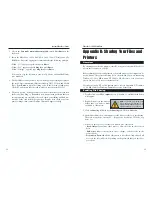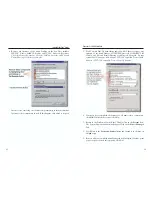
each of the packets if more than one is required) and sends it to the IP address
that is obtained by looking up the domain name in the Uniform Resource
Locator you requested or in the e-mail address you're sending a note to. At the
other end, the recipient can see the IP address of the Web page requestor or the
e-mail sender and can respond by sending another message using the IP address
it received.
IPX
(
I
nternetwork
P
acket E
X
change) - A NetWare communications protocol
used to route messages from one node to another. IPX packets include network
addresses and can be routed from one network to another.
IRQ
(
I
nterrupt
R
e
Q
uest) - A hardware interrupt on a PC. There are 16 IRQ
lines used to signal the CPU that a peripheral event has started or terminated.
Except for PCI devices, two devices cannot use the same line.
ISP
- An ISP (Internet Service Provider) is a company that provides individu-
als and companies access to the Internet and other related services such as Web
site building and virtual hosting.
LAN
- A local area network (LAN) is a group of computers and associated
devices that share a common communications line and typically share the
resources of a single processor or server within a small geographic area (for
example, within an office building).
MAC
(
M
edia
A
ccess
C
ontrol
A
ddress) - A unique number assigned by the
manufacturer to any Ethernet networking device, such as a network adapter,
that allows the network to identify it at the hardware level.
Mbps
(
M
ega
B
its
P
er
S
econd) - One million bits per second; unit of measure-
ment for data transmission.
Motherboard
- A motherboard is the physical arrangement in a computer that
contains the computer's basic circuitry and components.
NetBEUI
(
NetB
IOS
E
xtended
U
ser
I
nterface) - The transport layer for
NetBIOS. NetBIOS and NetBEUI were originally part of a single protocol
suite that was later separated. NetBIOS sessions can be transported over
NetBEUI, TCP/IP and SPX/IPX protocols.
NetBIOS
- The native networking protocol in DOS and Windows networks.
Although originally combined with its transport layer protocol (NetBEUI),
NetBIOS today provides a programming interface for applications at the ses-
EtherFast
®
10/100 LAN Card
80
Unlike e-mail programs in which graphics and program files have to be
"attached," FTP is designed to handle binary files directly and does not add the
overhead of encoding and decoding the data.
Full Duplex
- The ability of a device or line to transmit data simultaneously in
both directions.
Half Duplex
- Data transmission that can occur in two directions over a single
line, but only one direction at a time.
Hardware
- Hardware is the physical aspect of computers, telecommunica-
tions, and other information technology devices. The term arose as a way to dis-
tinguish the "box" and the electronic circuitry and components of a computer
from the program you put in it to make it do things. The program came to be
known as the software.
HTTP
(
H
yper
T
ext
T
ransport
P
rotocol) - The communications protocol used
to connect to servers on the World Wide Web. Its primary function is to estab-
lish a connection with a Web server and transmit HTML pages to the client
browser.
Hub
- The device that serves as the central location for attaching wires from
workstations. Can be passive, where there is no amplification of the signals; or
active, where the hubs are used like repeaters to provide an extension of the
cable that connects to a workstation.
IEEE
- The Institute of Electrical and Electronics Engineers. The IEEE
describes itself as "the world's largest technical professional society -- promot-
ing the development and application of electrotechnology and allied sciences
for the benefit of humanity, the advancement of the profession, and the well-
being of our members."
The IEEE fosters the development of standards that often become national and
international standards. The organization publishes a number of journals, has
many local chapters, and several large societies in special areas, such as the
IEEE Computer Society.
IP Address
- In the most widely installed level of the Internet Protocol
(Internet Protocol) today, an IP address is a 32-binary digit number that identi-
fies each sender or receiver of information that is sent in packet across the
Internet. When you request an HTML page or send e-mail, the Internet
Protocol part of TCP/IP includes your IP address in the message (actually, in
Instant EtherFast
®
Series
79





































